1. Search for Microbiota Entries
In the field of “Search for MIC Entries”, users can find microbes by searching microbe species name, MIC id, host genetic factor (HGF) name, host immune factor (HIF) name, HGF ID, HIF ID, disease name and ICD-11 code among the entire textual component of GIMICA. Query can be submitted by entering keywords into the main searching frame. The resulting webpage displays profiles of all the MICs directly related to the search term, including MIC ID, MIC name, phylum and host factor options. By clicking the hyperlink “MIC Info”, the details of microbe species, which include general information of MIC, host genetic factors regulating this MIC, host immune factors regulating this MIC and environmental factors regulating this MIC will be displayed. Also, you can also get the details of microbe species regulated by HGF by clicking the host genetic factor hyperlink “HGF Info” and get the details of microbe species regulated by HIF by clicking the hyperlink “HIF Info”. To facilitate a more customized input query, the wild characters of “*” and “?” are also supported in GIMICA.
1. If search: “Escherichia coli”, find single MIC entry which is named as “Escherichia coli (enterobacteria)”;
2. If search: “MIC00702”, find corresponding MIC “Lactobacillus acidophilus (firmicutes)” with this MIC ID;
3. If search: “Obesity”, find 25 microbes associated with this disease;
4. If search: “hsa-miR-125b-5p”, find hundreds of microbes regulated by the miRNA “hsa-miR-125b-5p”;
5. If search: “Candida ?”, find a variety of microbes belonging to the Candida genus. Here“?” represents any single character;
6. If search: “Candida *”, find all microbes whose name have this word. Here “*” represents an arbitrary string.
For example: if you want to know the detail information of “Escherichia coli”, you can search it by typing “Escherichia coli” in the “Search for MIC Entries” field. The brief information of Escherichia coli will be provided.

By clicking the “MIC Info” button, the detailed information page of “Escherichia coli” will be displayed. Details of Microbe Species (MIC) is divided into four parts, “General Information of MIC”, “Host Genetic Factors (HGFs)”, “Host Immune Factors (HIFs)” and “Environmental Factor(s)”. The general information of “Escherichia coli” including its “MIC Name”, “MIC Synonyms”, “Body Site”, Lineage”, “Oxygen Sensitivity”, “Microbial Metabolism”, “Gram”, “Host Relationship”, “External Links”, “Description” and “Disease Relevance”. If you want to know more about “Escherichia coli”, you can link to other related databases by clicking the hyperlinks in the “External Links” field.
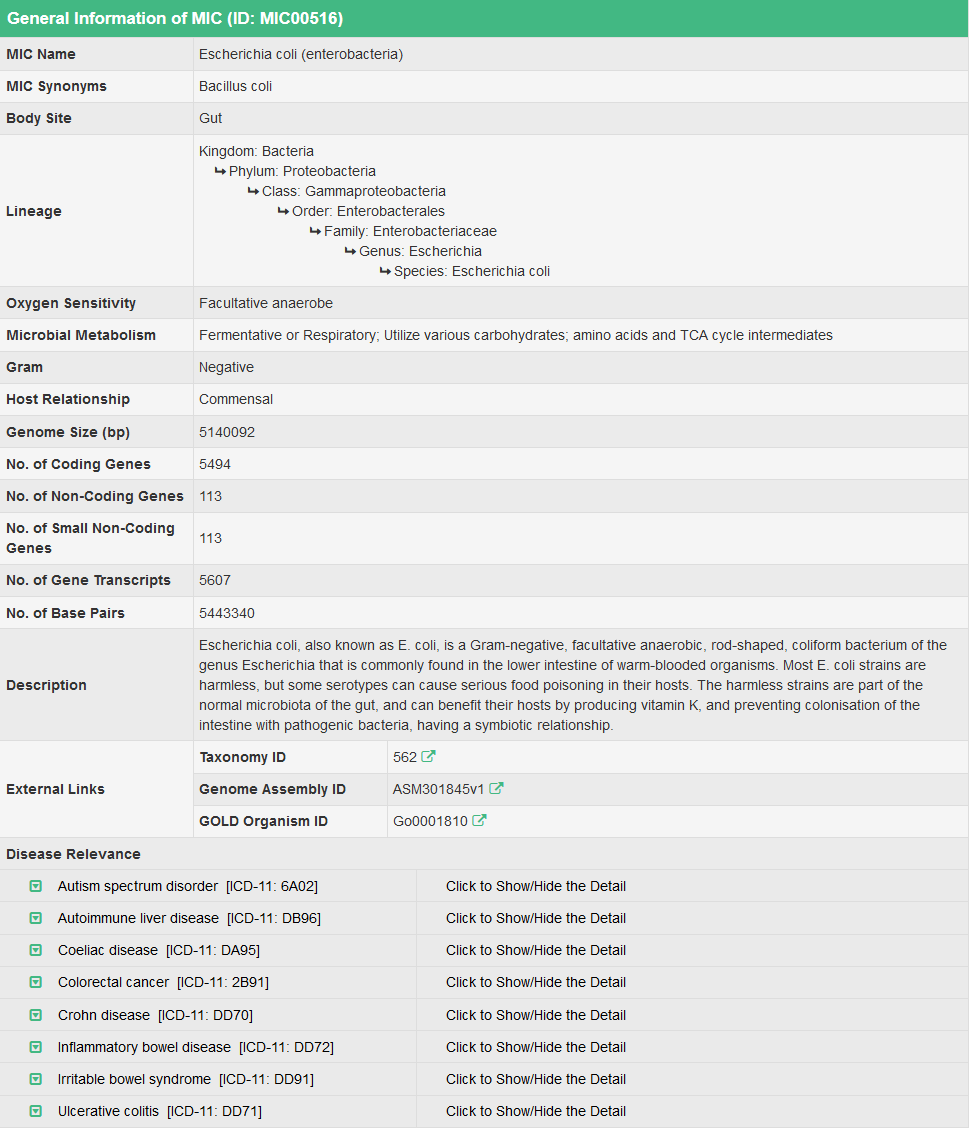
“Host Genetic Factors (HGFs)” includes the genetic factors that regulate “Escherichia coli”. By clicking on the a specific HGF, the general information will be displayed.
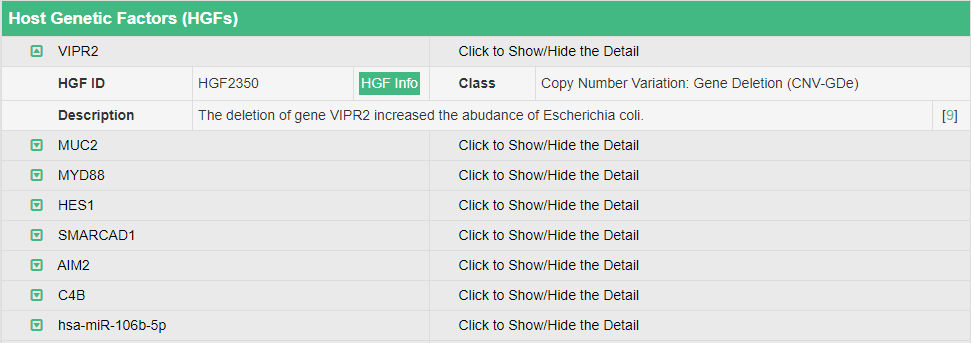
By clicking on the “HGF Info” hyperlink, the details of this host genetic factor shaping human microbiota will be displayed.
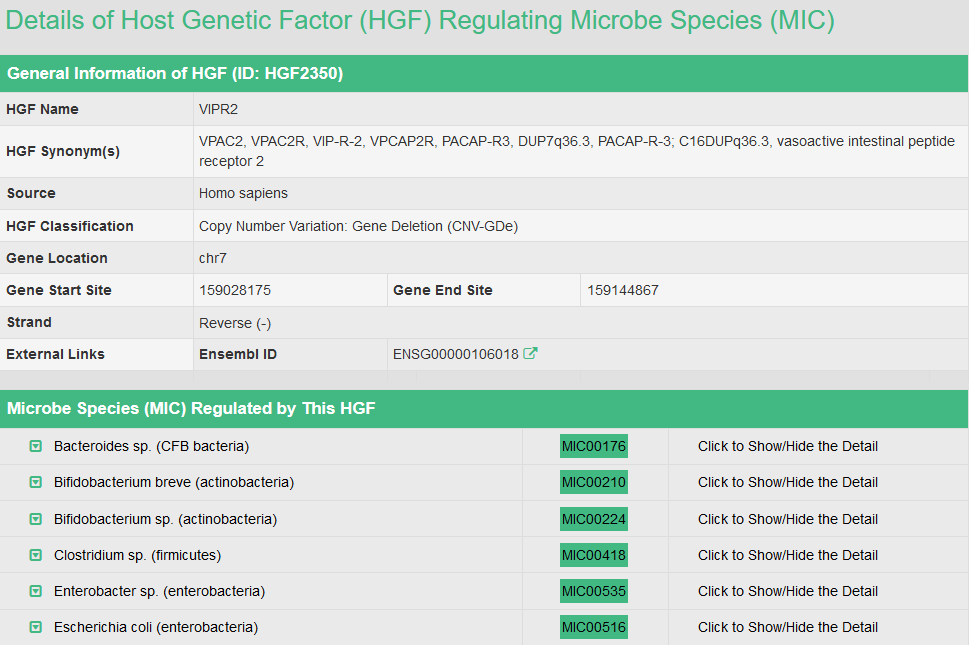
“Host Immune Factors (HIFs)” includes the immune factors that regulate “Escherichia coli”. By clicking on a specific HIF, the general information will be displayed.
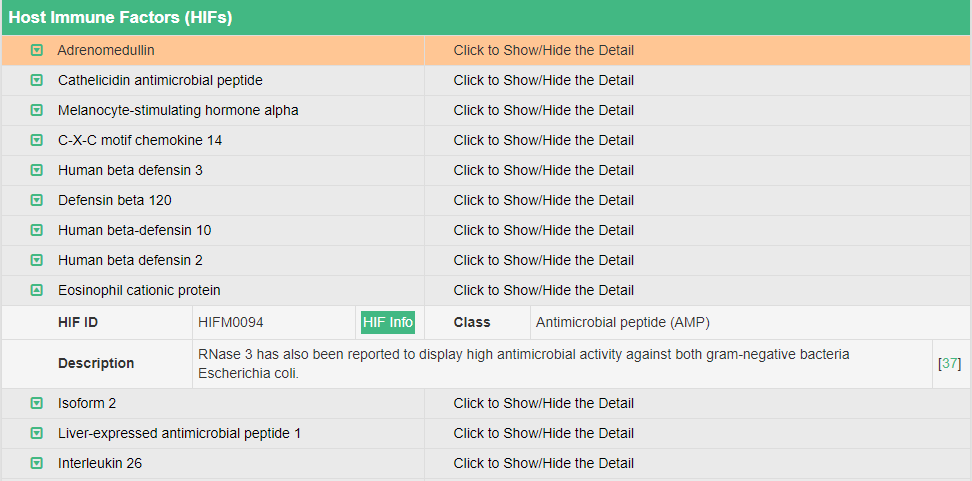
By clicking the “HIF Info” hyperlink of Eosinophil cationic protein, the details of Eosinophil cationic protein and the microbes regulated by this HIF will be displayed.
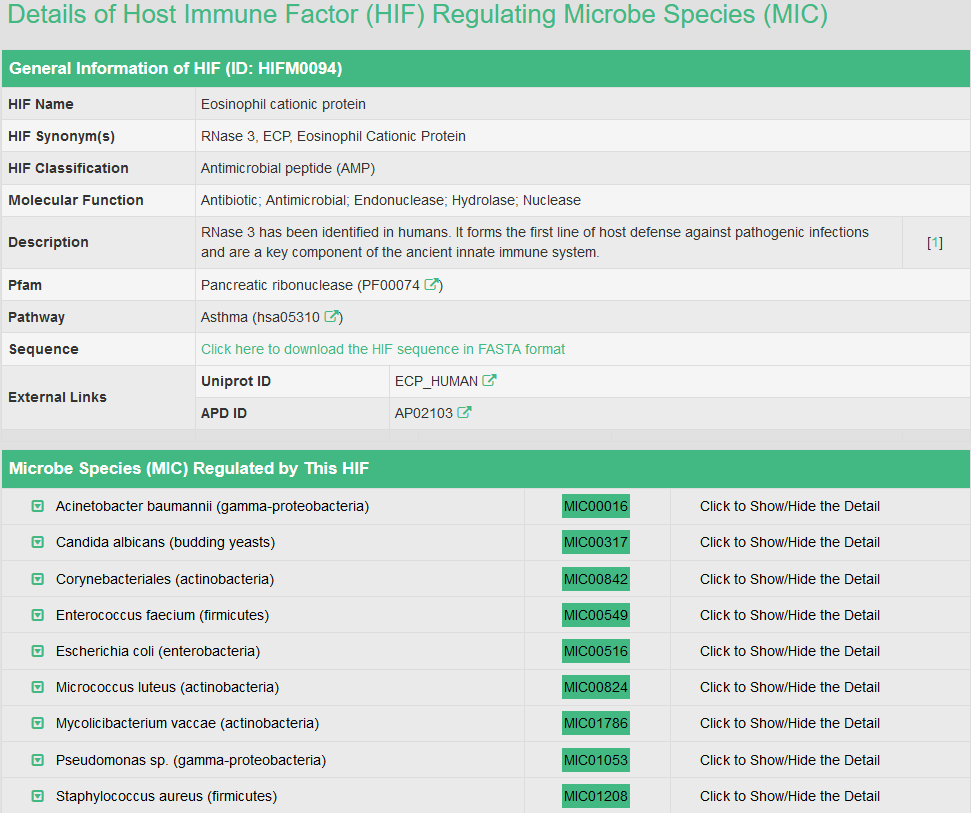
“Environmental Factor(s)” displays three databases providing the environmental factors that regulate “Escherichia coli” and the corresponding hyperlinks are provided.

2. Search for MIC Entries by MIC Name based on Taxonomic Phylum
Alternatively, in the field of “Search for MIC Entries by MIC Name based on Taxonomic Phylum”, users can find MIC entries by searching phylum-MIC name pair among the entire textual component of GIMICA. First, users should select a phylum from the drop-down list in the first column. Then corresponding MIC name options will become available after a short period of time. By clicking “Search” button, the brief information of the selected MIC will be shown.
For example, if you want to know the detail information of “Eggerthella lenta”, you can select “Actinobacteria” in the “Step 1: Please select a phylum name” column and then select “Eggerthella lenta” in the “Step 2: Please select a MIC name” drop-down list. After clicking the “Search” button, the brief information of “Eggerthella lenta” will be provided.
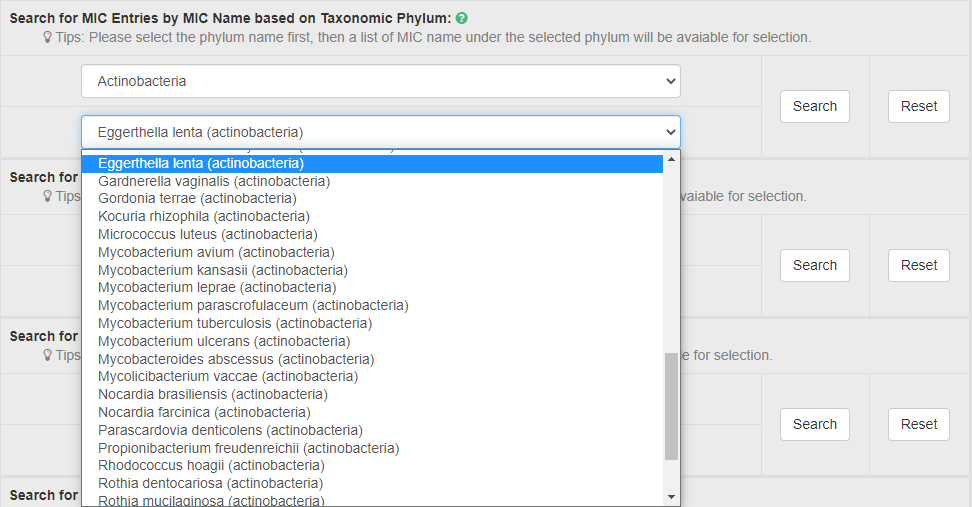
By clicking the “MIC Info” button, the detailed information page of “Eggerthella lenta” will be displayed.

3. Search for MIC Entries by MIC Name based on Human Body Site
Alternatively, in the field of “Search for MIC Entries by MIC Name based on Human Body Site”, users can find MIC entries based on body site-MIC name pair among the entire textual component of GIMICA. First, users should select the human body type from the drop-down list in the first column. Then a list of MIC name under the selected type will be available for selection after a short period of time. By clicking “Search” button, the brief information of the selected MIC will be shown.
For example, if you want to know the detail information of “Escherichia coli”, you can select “Gut” in the “Step 1: Please Select a Human Body Site” column and then select “Escherichia coli (enterobacteria)” in the “Step 2: Please Select a MIC Name” drop-down list. After clicking the “Search” button, the brief information of “Escherichia coli” will be provided.
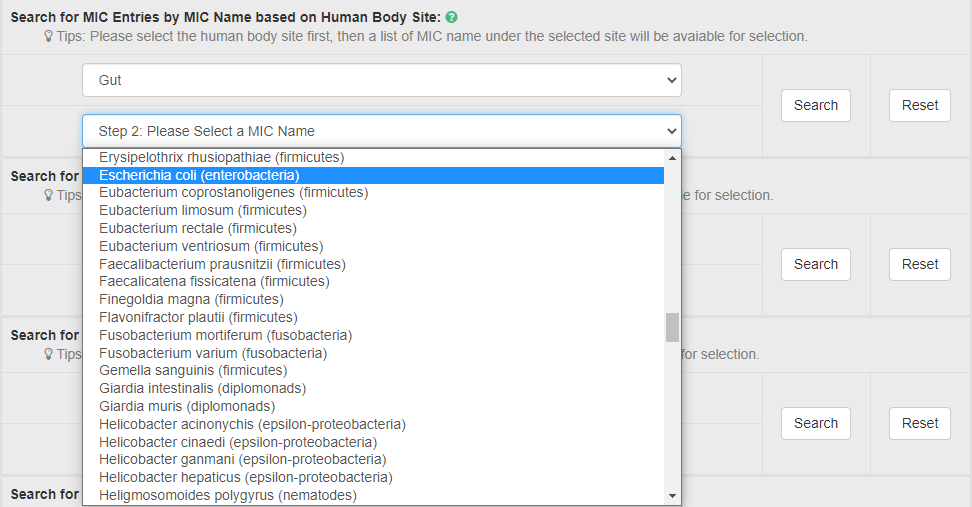
By clicking the “MIC Info” button, the detailed information page of “Escherichia coli” will be displayed.

4.Search for MIC Entries by the Name of Host Genetic Factor (HGF) based on HGF Type
Alternatively, in the field of “Search for MIC Entries by the Name of Host Genetic Factor (HGF) based on HGF Type”, users can find MIC entries by the name of host genetic factor type-name pair among the entire textual component of GIMICA. First, users should select a HGF type from the drop-down list in the first column. Then a list of HGF name under the selected type will be available for selection. By clicking “Search” button, the brief information of MIC regulated by the selected HGF will be shown.
For example, if you want to know the microbes regulated by miRNA “hsa-let-7”, you can select “Non-coding RNA: Micro (ncRNA-miRNA)” in the “Step 1: Please Select a HGF Type Name” column and then select “hsa-let-7” in the “Step 2: Please Select a HGF Name” drop-down list. After clicking the “Search” button, the microbes regulated by human miRNA “hsa-let-7” will be provided.
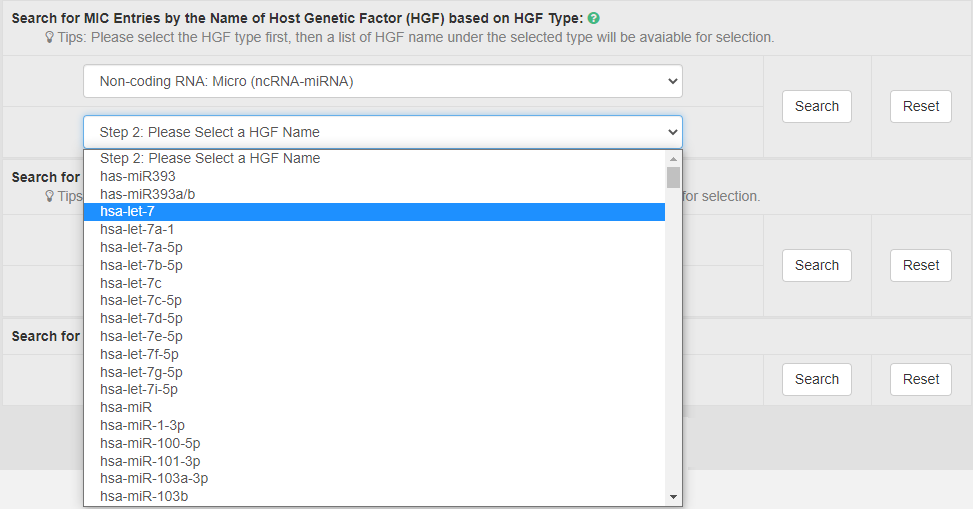
By clicking the “MIC Info” button, the detailed information page of Helicobacter pylori will be displayed.

5.Search for MIC Entries by the Name of Host Immune Factor (HIF) based on HIF Type
Alternatively, in the field of “Search for MIC Entries by the Name of Host Immune Factor (HIF) based on HIF Type”, users can find MIC entries by the name of host immune factor type-name pair among the entire textual component of GIMICA. First, users should select the HIF type name from the drop-down list in the first column. Then a list of HIF name under the selected type will be available for selection. By clicking “Search” button, the brief information of MIC regulated by the selected HIF will be shown.
For example, if you want to know the microbes regulated by HIF “CD14+ monocytes”, you can select “Monocytes (Mono)” in the “Step 1: Please Select a HIF Type Name” column and then select “CD14+ monocytes” in the “Step 2: Please Select a HIF Name” drop-down list. After clicking the “Search” button, the brief information of MIC regulated by HIF “CD14+ monocytes” will be provided.
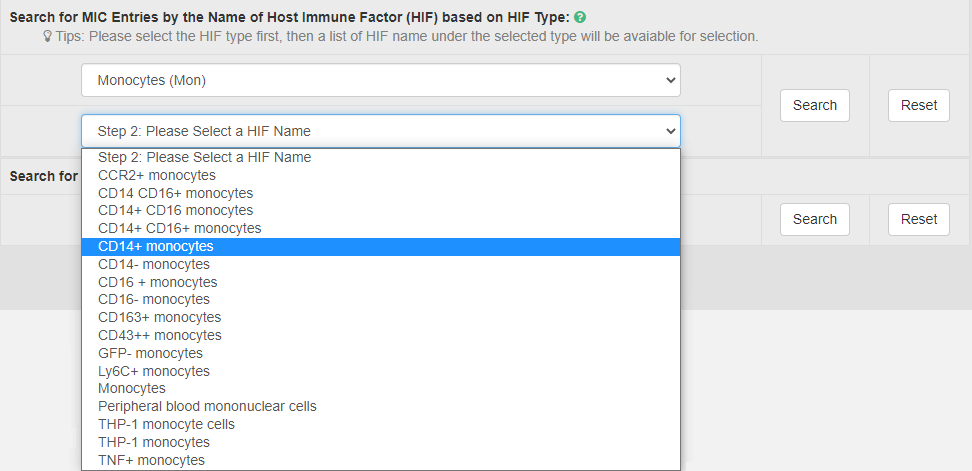
By clicking the “MIC Info” button, the detailed information page of MIC regulated by CD14+ monocytes will be displayed.
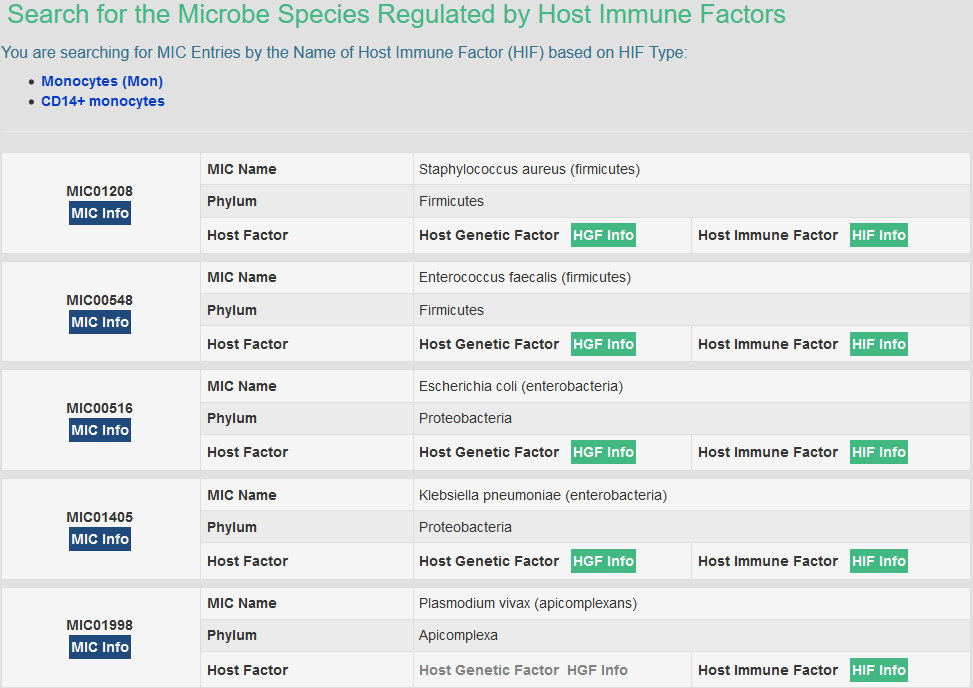
6. Search Microbiota by ICD-11 Defined Disease Class
In this field, users can search GIMICA microbiota entries related to a specific disease. There is an urgent need to enable data retrieval by using the widely used International Classification of Diseases (ICD) codes for facilitating broader, more convenient and automatic data access, processing and exchange by the bench-to-clinic communities, particularly non-domain experts. ICD has been developed by the World Health Organization (WHO), sponsored by the United Nations, adopted by >110 countries and used by physicians, researchers, nurses, health workers, health information managers, policy makers, insurers and health program managers for defining and studying diseases, monitoring and managing health care and allocating resources. In GIMICA, users can search GIMICA MIC entries by selecting a certain ICD code from the drop-down list.
For example: If search “1C17: Diphtheri”, users can access to basic information of MIC associated with this disease. If you want to know more about this MIC, you can click the corresponding “MIC Info” button.


7. Search for the Microbe Species Regulated by Host Genetic Factors
In this field, users can find interactions between MIC and HGF by searching MIC name, MIC ID, HGF name, HGF ID and disease name among the entire textual component of GIMICA. Query can be submitted by entering keywords into the main searching frame. The resulting webpage displays profiles of all the MICs directly related to the search term, include MIC ID, MIC name, phylum and host genetic factor. By clicking the hyperlink “HGF Info”, the details of MIC regulated by HGF in GIMICA will be displayed. “Host Genetic Factors (HGFs)” includes the genetic factors regulating the searched MIC. To facilitate a more customized input query, the wild characters of “*” and “?” are also supported.
1. If search: “Bordetella pertussis”, find single entry of microbe “Bordetella pertussis”;
2. If search: “MIC00669”, find single entry of MIC “Helicobacter pylori” with this MIC ID;
3. If search: “hsa-miR-576-5p”, find various entries of microbe species regulated by the HGF “hsa-miR-576-5p”;
4. If search: “Gastric ulcer”, find one MIC entry associated with the disease “Gastric ulcer”;
5. If search: “Bifidobacterium ?”, find a variety of MICs such as “Bifidobacterium thermophilum (actinobacteria)” and “Bifidobacterium scardovii (actinobacteria)”. Here “?” represents any single character. Also, “*” represents an arbitrary string.
For example, if you search “Bordetella pertussis”, basic information about “Bordetella pertussis” will be displayed.

By clicking the hyperlink “HGF Info”, the details of “Bordetella pertussis” regulated by host genetic factors will be displayed. This page provides “General Information of MIC” and “Host Genetic Factors (HGFs)”.
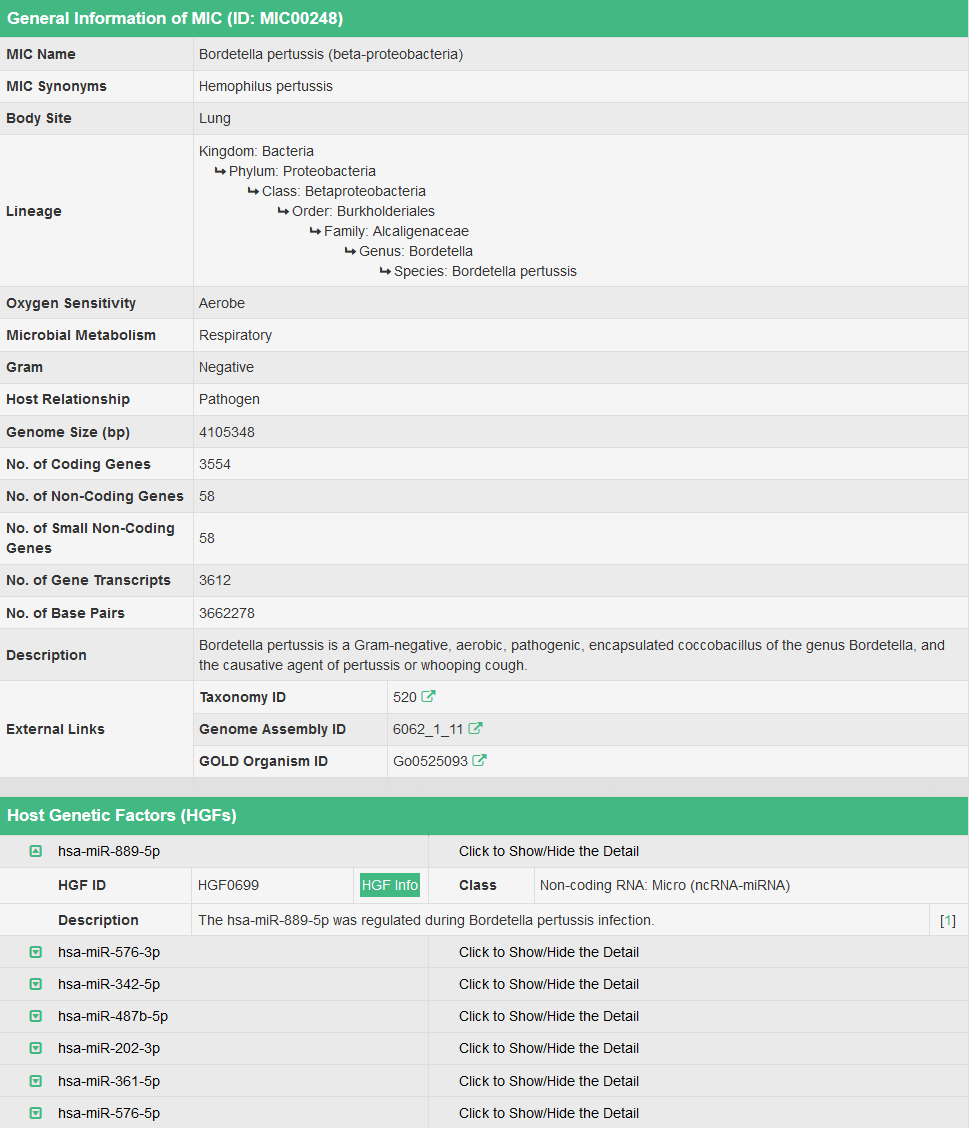
By clicking the hyperlink “HGF Info” of hsa-miR-889-5p, the general information of this HGF will be displayed. This page provides “General Information of HGF” and “Microbe Species (MIC) Regulated by This HGF”.
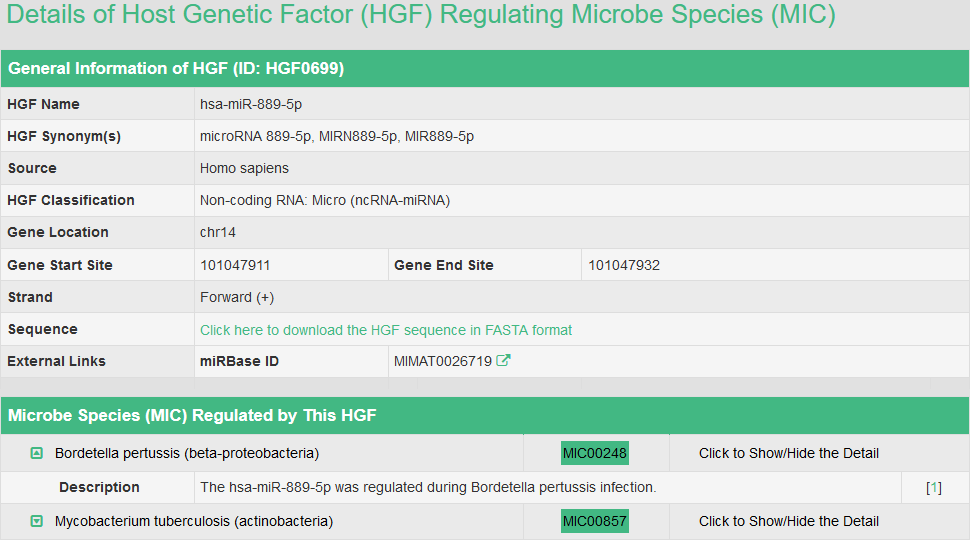
8. Search for MIC Entries by MIC Name based on Taxonomic Phylum
Alternatively, in the field of “Search for MIC Entries by MIC Name based on Taxonomic Phylum”, users can find MIC regulated by the HGF based on phylum-species name pair among the entire textual component of GIMICA. First, users should select the phylum name from the drop-down list in the first column. Then a list of MIC name under the selected type will be available for selection after a short period of time. By clicking “Search” button, the brief information of the selected MIC from specific species will be shown.
For example, if you want to know the detailed information of “Bacteroides fragilis” regulated by HGF, you can select “Bacteroidetes” in the “Step 1: Please Select a Phylum Name” column and then select “Bacteroides fragilis” in the “Step 2: Please Select a MIC Name” drop-down list. After clicking the “Search” button, the brief information of “Bacteroides fragilis (CFB bacteria)” will be provided.
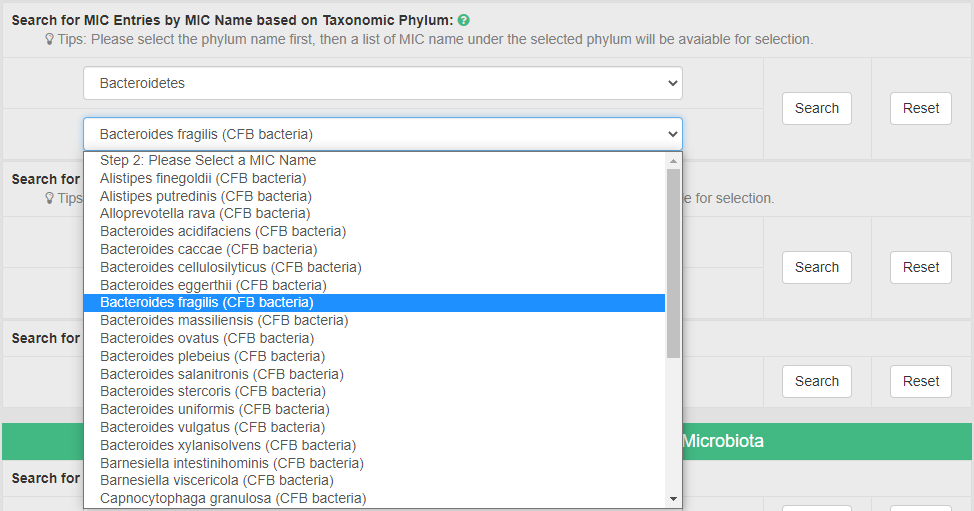
By clicking the “HGF Info” button, the details of microbe species regulated by HGF will displayed.

9. Search for MIC Entries by the Name of Host Genetic Factor (HGF) based on HGF Type
Alternatively, in the field of “Search for MIC Entries by the Name of Host Genetic Factor (HGF) based on HGF Type”, users can find MIC regulated by HGF by the name of HGF based on HGF type pair among the entire textual component of GIMICA. First, users should select the HGF type name from the drop-down list in the first column. Then a list of HGF name under the selected type will be available for selection after a short period of time. By clicking “Search” button, the brief information of the selected MIC from specific species will be shown.
10. Search for MIC Entries by ICD-11 Defined Disease Class
In this field, users can search MIC information by selecting a certain ICD code from the drop-down list. For example, if search “1D01: Meningitis”, users can access to basic information of microbes regulated by HGF and associated with the meningitis disease.
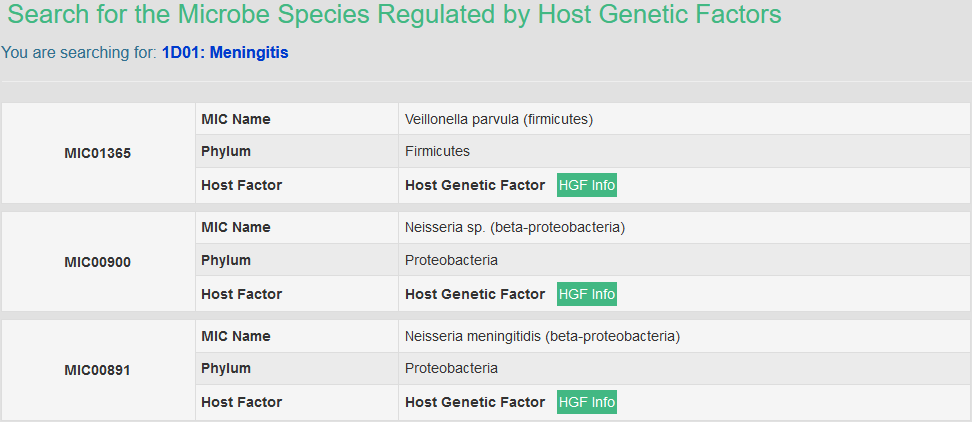
11. Search for the Host Genetic Factor (HGF) Shaping Human Microbiota
In this field, users can find interactions between host genetic factor and human microbiota by searching MIC name, MIC ID, HGF name, HGF ID and disease name among the entire textual component of GIMICA. Query can be submitted by entering keywords into the main searching frame. The resulting webpage displays profiles of all the HGFs directly related to the search term, including HGF name, type and classification. By clicking the hyperlink “HGF Info”. The details of HGF will be displayed. In addition to showing general information of HGF, there are also MICs regulated by the searched HGF. To facilitate a more customized input query, the wild characters of “*” and “?” are also supported.
1. If search: “Neisseria”, find various entries of MIC associated with “Neisseria”;
2. If search: “HGF0207”, find single entry of HGF “hsa-miR-204-5p”;
3. If search: “Gastric ulcer”, find various entries of HGF associated with the disease “Gastric ulcer”;
4. If search: “125b- ?”, find a variety of HGFs named as “hsa-miR-125b-5p”, and “hsa-miR-125b-2-3p”. Here“?” represents any single character. Also, “*” represents an arbitrary string.
For example, if you search “Bordetella pertussis”, All HGFs that regulate “Bordetella pertussis” will be displayed.
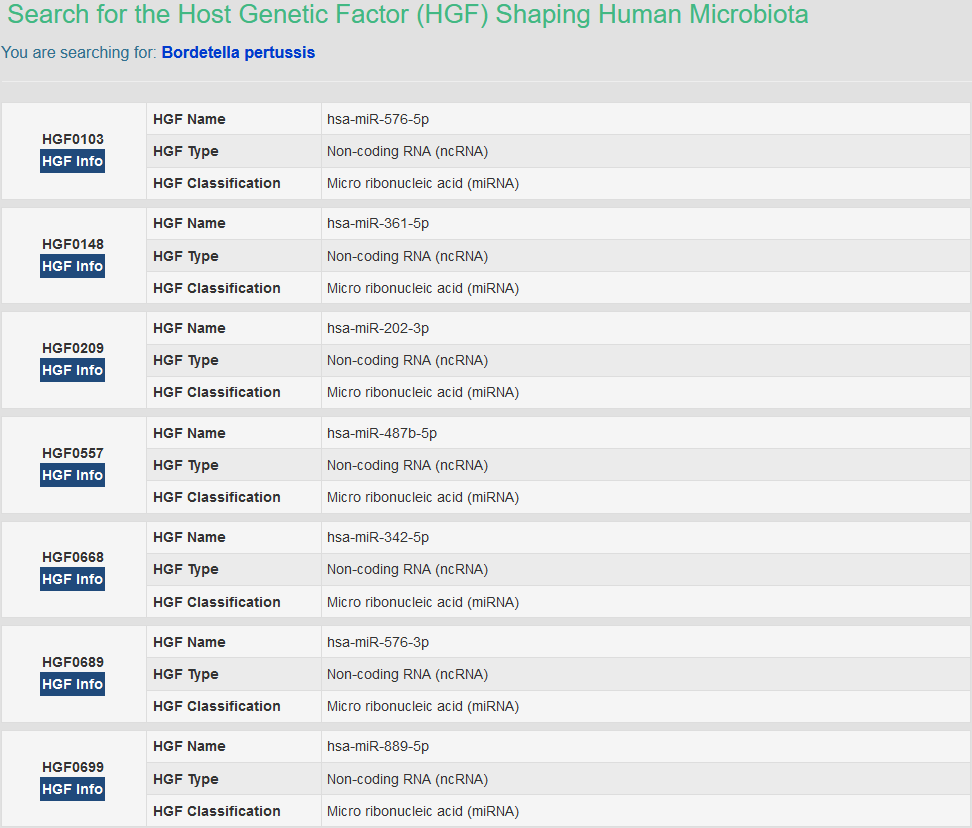
By clicking the hyperlink “HGF Info” of HGF0148, details of this HGF will be displayed, which include “General Information of HGF” and “Microbe Species (MIC) Regulated by This HGF”.
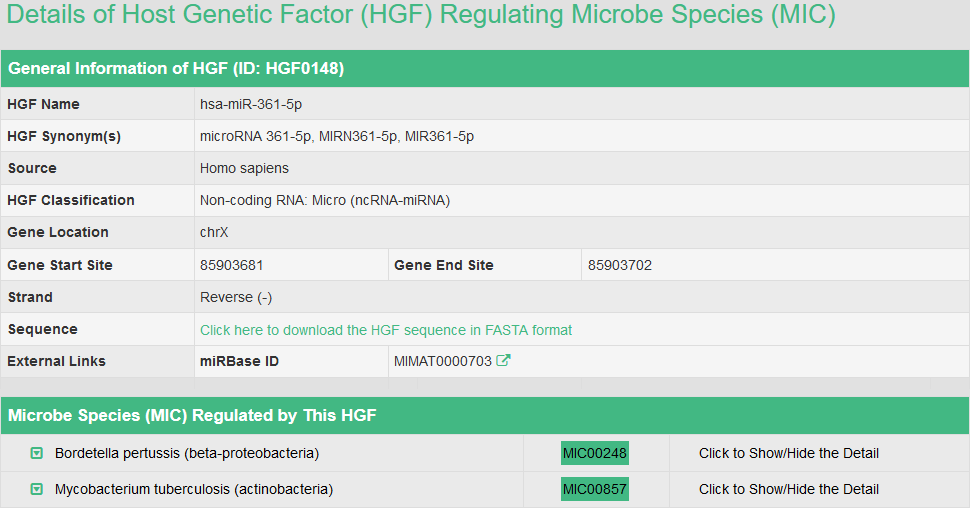
12. Search for HGF Entries by MIC Name based on Taxonomic Phylum
Alternatively, in the field of “Search for HGF Entries by MIC Name based on Taxonomic Phylum”, users can find HGFs regulating the selected MIC based on phylum-species name pair among the entire textual component of GIMICA. First, users should select the phylum name from the drop-down list in the first column. Then a list of MIC name under the selected type will be available for selection after a short period of time. By clicking “Search” button, the brief information of HGFs regulating the selected MIC will be shown.
13. Search for HGF Entries by HGF Name based on HGF Type
In the field of “Search for HGF Entries by HGF Name based on HGF Type”, users can find HGFs regulating MIC based on HGF type-name pair among the entire textual component of GIMICA. First, users should select a HGF type from the drop-down list in the first column. Then a list of HGF name under the selected type will be available for selection after a short period of time. By clicking “Search” button, the brief information of the selected HGF will be shown.
14. Search for HGF Entries by ICD-11 Defined Disease Class
In this field, users can search HGF information by selecting a certain ICD code from the drop-down list. Users can access to basic information of HGF regulating the MIC that are associated with the selected disease.
15. Search for the Microbe Species Regulated by Host Immune Factors (HIF)
In this field, users can find interactions between MIC and HIF by searching MIC name, MIC ID, HIF name, HIF ID and disease name among the entire textual component of GIMICA. Query can be submitted by entering keywords into the main searching frame. The brief information of the MIC which is regulated by HIF will be displayed. By clicking the hyperlink “HIF Info”, the details of MIC regulated by HIF will be displayed which include “General Information of MIC and “Host Immune Factors (HIFs)”. To facilitate a more customized input query, the wild characters of “*” and “?” are also supported in GIMICA.
1. If search: “Bacillus subtilis”, find single entry of MIC regulated by HIF;
2. If search: “MIC00302”, find single entry of MIC Campylobacter concisus regulated by HIF;
3. If search: “Regulatory T cells”, find various entries of MIC regulated by the immune factor “Regulatory T cells”;
4. If search: “Ulcerative colitis”, find various entries of MIC associated with the disease name “Ulcerative colitis”;
5. If search: “B cells ?”, find various entries of MIC regulated by the HIFs whose name have “B cells”. Here“?” represents any single character. Also, “*” represents an arbitrary string.
For example: if you want to know the detail information of MIC “Akkermansia muciniphila” regulated by HIF, you can search it by typing “Akkermansia muciniphila” in the “Search for Entries” field. The brief information of “Akkermansia muciniphila” will be provided.

By clicking the “HIF Info” button, the details of MIC “Akkermansia muciniphila” will be displayed which include “General Information of MIC” and “Host Immune Factors (HIFs)”.
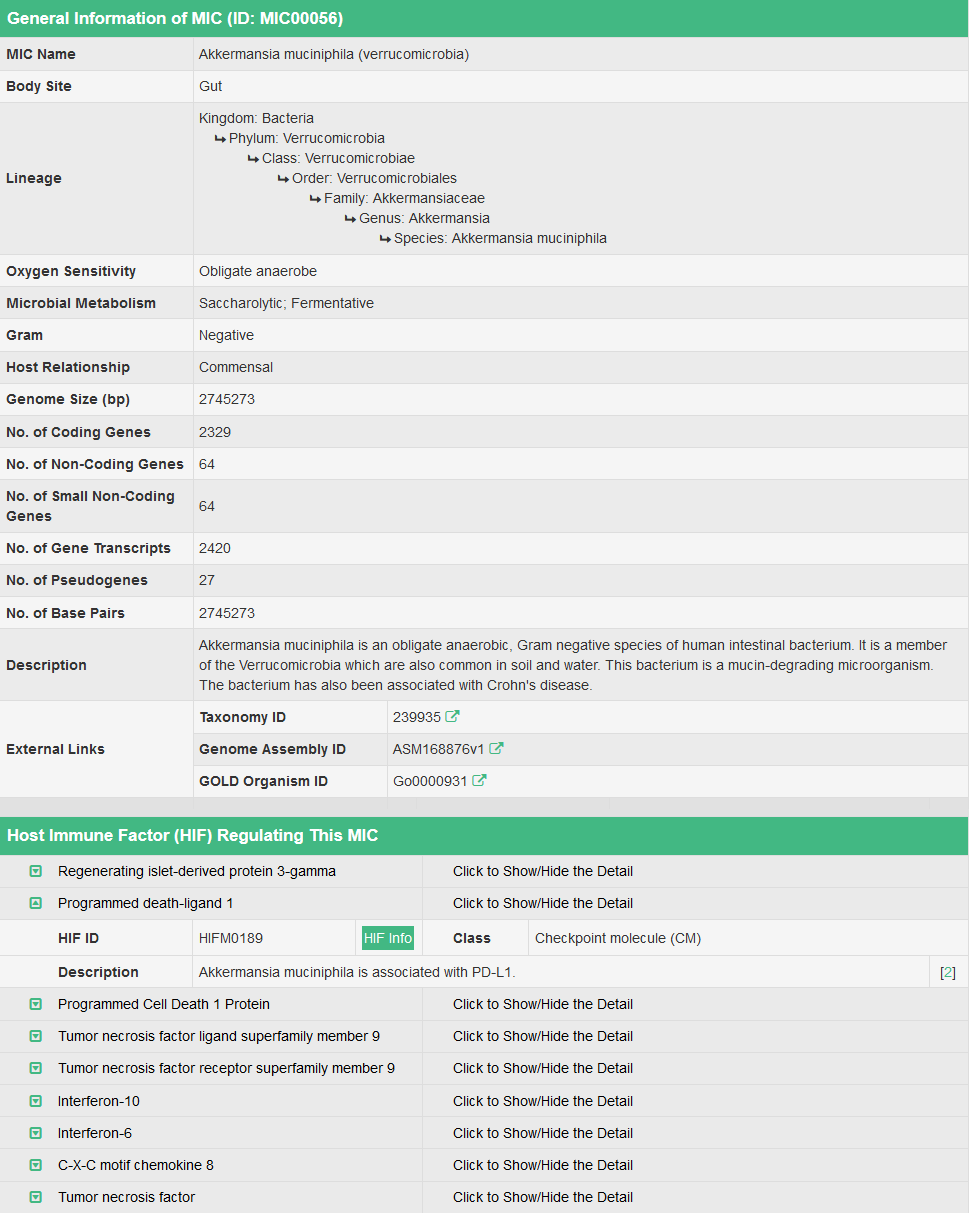
You can get information of HIF which regulates the Akkermansia muciniphila by clicking the specific “HIF Info”, such as “Programmed death-ligand 1”. The resulting page includes “General Information of HIF” and “Microbe Species (MIC) Regulated by This HIF”.
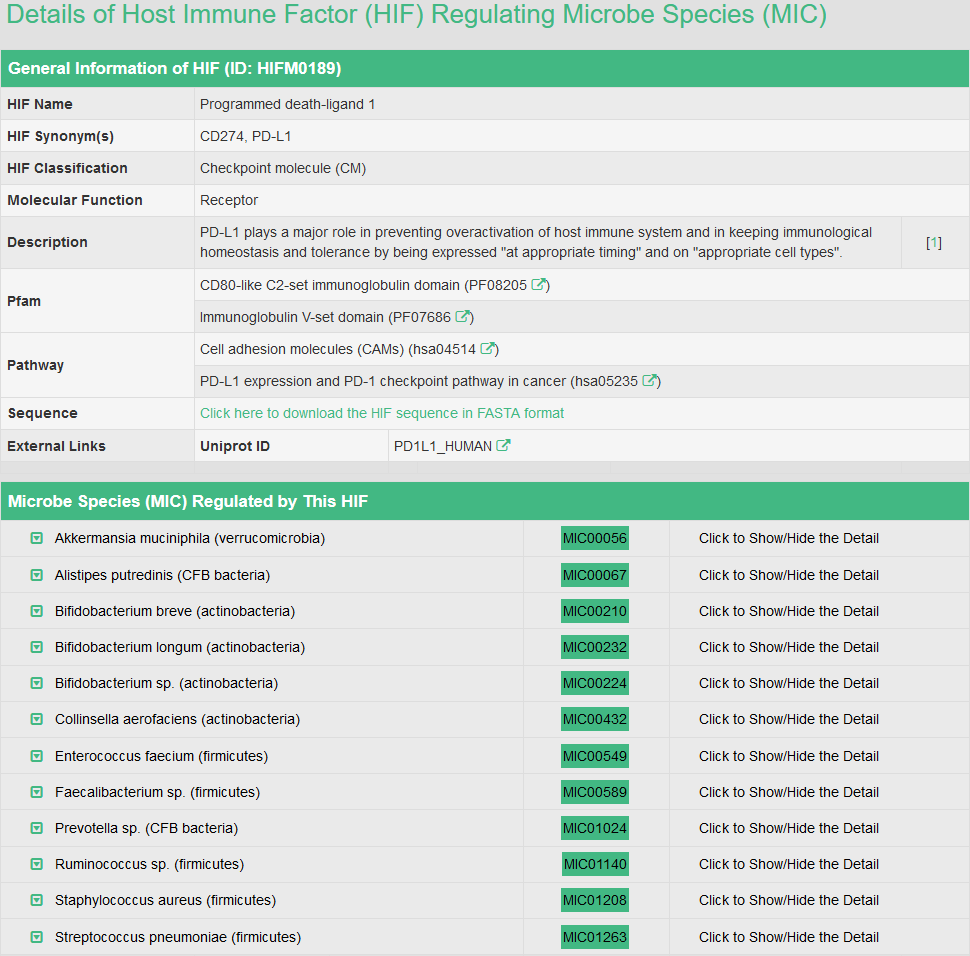
16. Search for MIC Entries by MIC Name based on Taxonomic Phylum
Alternatively, in the field of “Search for MIC Entries by MIC Name based on Taxonomic Phylum”, users can find MIC Entries regulated by HIF based on phylum-species name pair among the entire textual component of GIMICA. First, users should select the phylum name from the drop-down list in the first column. Then a list of MIC name under the selected type will be available for selection. By clicking “Search” button, the brief information of the selected MIC will be shown.
For example, if you want to know the MIC entries of “Bacillus firmus”, you can select “Firmicutes” in the “Step 1: Please Select a Phylum Name” column and then select “Bacillus firmus (firmicutes)” in the “Step 2: Please Select a MIC Name” drop-down list.
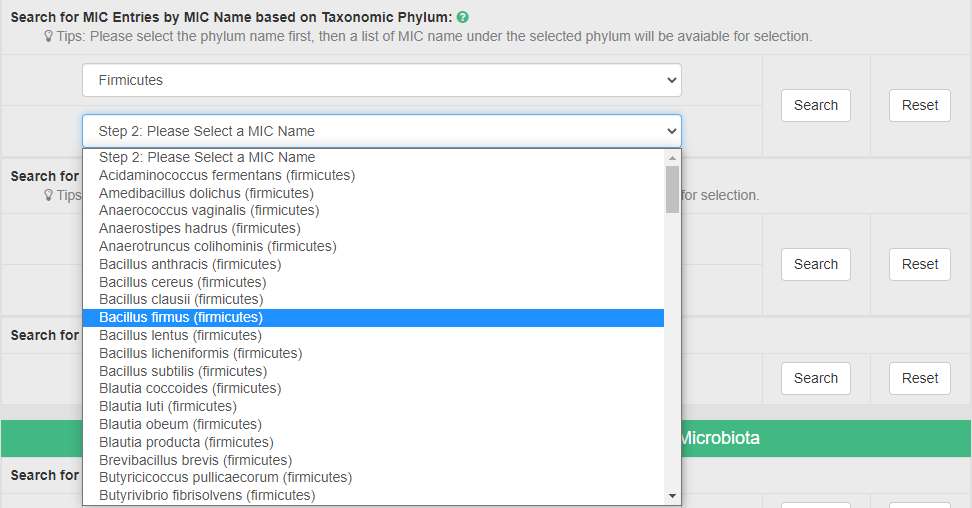
After clicking the “Search” button, the brief information of MIC “Bacillus firmus” will be displayed.

17. Search for MIC Entries by the Name of Host Immune Factor (HIF) based on HIF Type
Alternatively, in the field of “Search for MIC Entries by the Name of Host Immune Factor (HIF) based on HIF Type”, users can find MIC entries based on HIF type-name pair among the entire textual component of GIMICA. First, users should select the HIF type name from the drop-down list in the first column. Then a list of HIF name under the selected type will be available for selection after a short period of time. By clicking “Search” button, the brief information of the selected MIC from specific species will be shown.
18. Search MICNR by ICD-11 Defined Disease Class
In this field, users can search MIC information by selecting a certain ICD code from the drop-down list. Users can access to the MICs which are regulated by HIF and associated with the selected disease.
19. Search for the Host Immune Factor (HIF) Shaping Human Microbiota
In this field, users can find certain HIF information by searching MIC name, MIC ID, HIF name, HIF ID and disease name among the entire textual component of GIMICA. Query can be submitted by entering keywords into the main searching frame. The resulting webpage displays profiles of all the HIFs directly related to the search term, including HIF name, HIF type and classification. By clicking the hyperlink “HIF Info”, the details of HIF regulating MIC will be displayed, which include “General Information of HIF” and “Microbe Species (MIC) Regulated by This HIF”. To facilitate a more customized input query, the wild characters of “*” and “?” are also supported in GIMICA.
1. If search: “Akkermansia muciniphila”, find various entries of HIFs regulating “Akkermansia muciniphila”;
2. If search: “HIFC0019”, find single entry of HIF “M1 macrophages”;
3. If search: “HIV”, find various entries of HIF associated with the disease “HIV”;
4. If search: “CD4+ ?”, find various HIFs which are named as “CD4+ regulatory T cells” , “CD4+CD25+ regulatory T cells” and so on. Here “?” represents any single character. Also, “*” represents an arbitrary string.
For example: if you want to which HIF can regulate MIC “Akkermansia muciniphila”, you can search it by typing “Akkermansia muciniphila” in the “Search for HIF Entries” field. The brief information of HIFs regulating “Akkermansia muciniphila” will be provided.
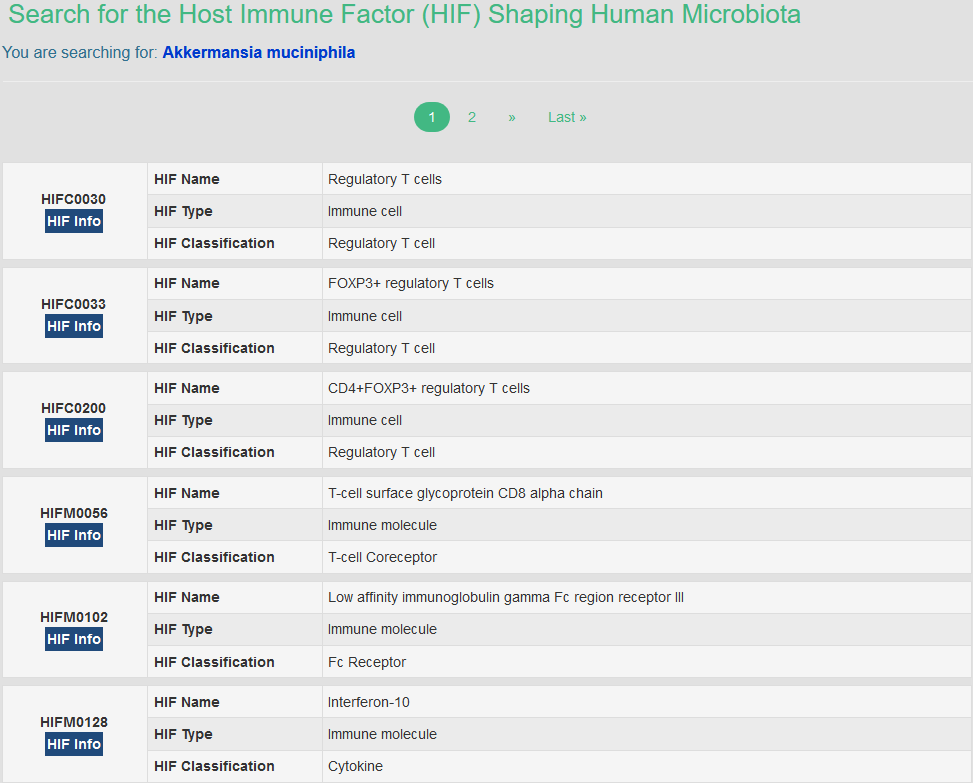
By clicking the HIF hyperlink of “HIFC0033”, the details of this HIF regulating MIC will be displayed.
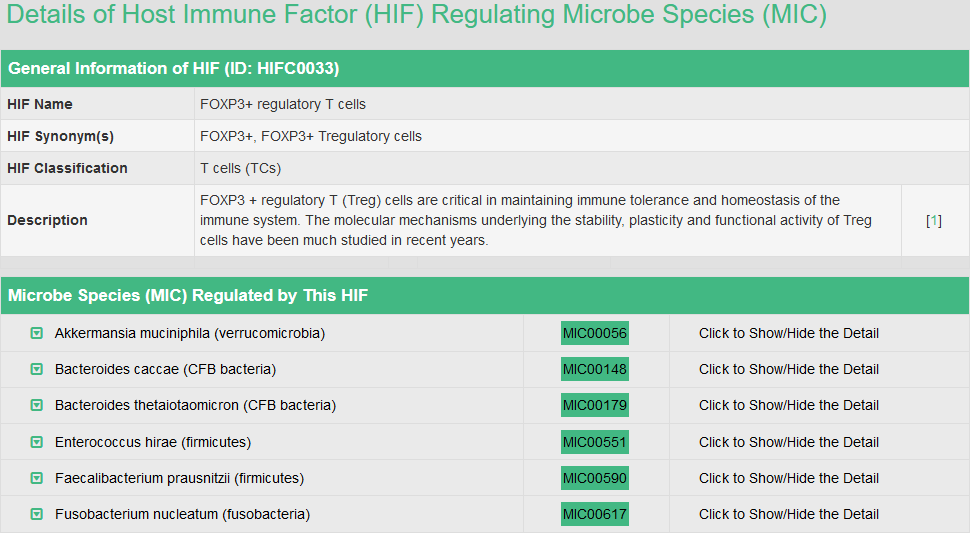
20. Search for HIF Entries by MIC Name based on Taxonomic Phylum
Alternatively, in the field of “Search for HIF Entries by MIC Name based on Taxonomic Phylum”, users can find HIF Entries based on phylum-species name pair among the entire textual component of GIMICA. First, users should select the phylum name from the drop-down list in the first column. Then a list of MIC name under the selected type will be available for selection after a short period of time. By clicking “Search” button, the brief information of the selected MIC from specific species will be shown.
For example, if you want to know the HIF entries regulating “Prevotella oralis”, you can select “Bacteroidetes” in the “Step 1: Please Select a Phylum Name” column and then select “Prevotella oralis (CFB bacteria)” in the “Step 2: Please Select a MIC Name” drop-down list.
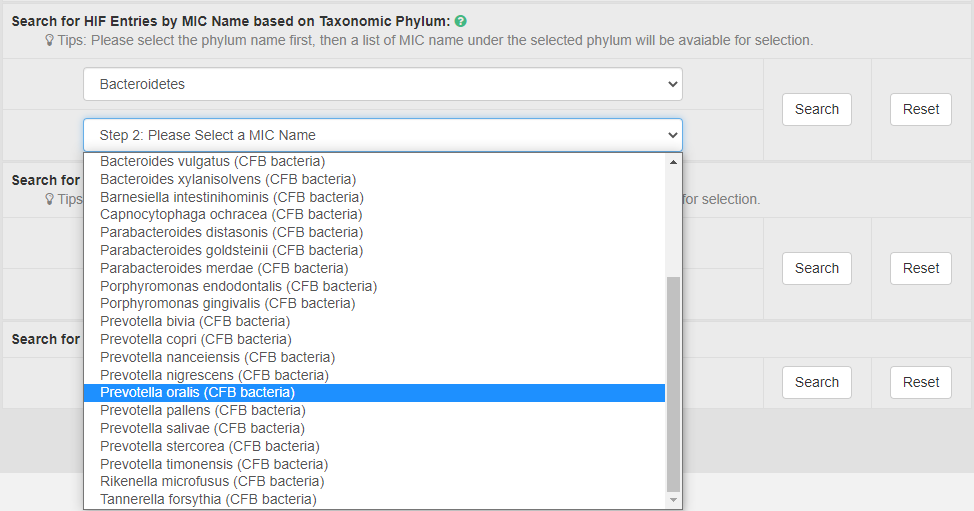
After clicking the “Search” button, the HIF entries regulating “Prevotella oralis” will be displayed.
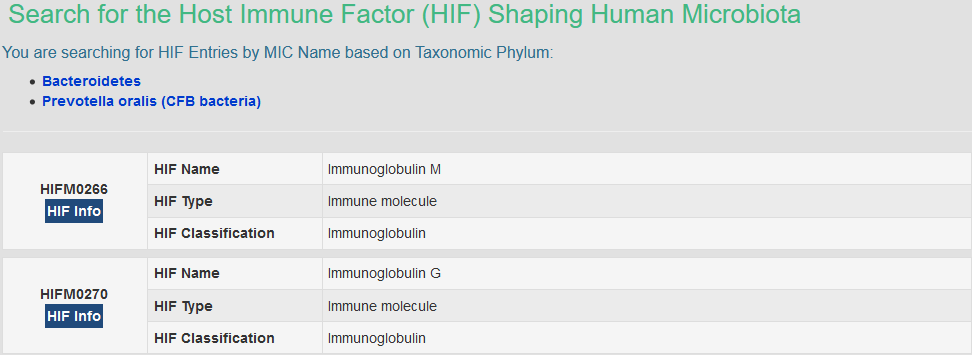
21. Search for HIF Entries by HIF Name based on HIF Type
In the field of “Search for HIF Entries by HIF Name based on HIF Type”, users can find HIF entries based on HIF type-name pair among the entire textual component of GIMICA. First, users should select the HIF type from the drop-down list in the first column. Then a list of HIF name under the selected type will be available for selection after a short period of time. By clicking “Search” button, the brief information of the selected HIF will be shown.
22. Search for HIF Entries by ICD-11 Defined Disease Class
In this field, users can search HIF information by selecting a certain ICD code. For example: if search “6B00: Anxiety disorder”, users can access to various entries of HIFs regulating MICs which are associated with the disease “6B00: Anxiety disorder”. The hyperlink “HIF Info” links to the detailed information page of each HIF.
23. Download the Full Data of GIMICA from A Variety of Customized Links
GIMICA provides functions for downloading all GIMICA data from various customized links..
(1) Data of microbe species, immune factors, genetic factors and disease information: (i) microbe species data (microbe species name / body site / genome statistics / lineage / metabolism / external links, etc.); (ii) host genetic factors data (genetic factor name / classification / sequence / external links, etc.); (iii) Host immune factors data (immune factor name / classification / pathway / Pfam / sequence / external links, etc.); (iiii) disease data (microbe species associated with various diseases / disease name / ICD-11 classification, etc.).
(2) Data of human microbiota regulated by host factors: (i) data of human microbiota shaped by host genetic factors (single nucleotide polymorphisms, copy number variations, non-coding RNAs, etc.); (ii) Data of human microbiota shaped by host immune factors (lymphocytes, phagocytes, immune proteins, immune pathways, etc.).
All data can be readily downloaded by simply clicking the corresponding “Click to Save” button.

